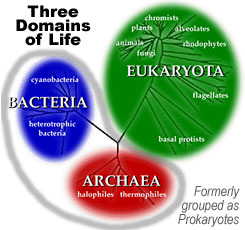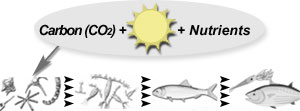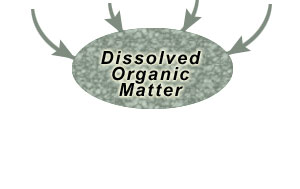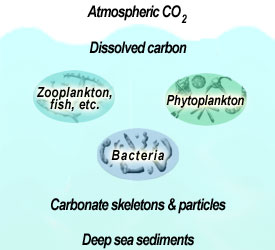
|
Bacteria were the sole occupants of our planet for more than half of the entire history of life; yet these single-celled organisms are among the smallest living things. These diverse creatures are abundant in all marine habitats, from the sea surface to the greatest depths. The role bacteria plays in cycling organics through the marine food web is being intensely studied... a puzzle that Bigelow Laboratory scientists are helping to solve. Are you a teacher? You may want to explore our Teacher Resources |
 |
|
|
Domains of Life, Bacteria &
Viruses
|
|
|
For many years, living organisms were divided into two kingdoms: Animalia (animal) and Plantae (vegetable). In the 1800s, scientists realized these two kingdoms could not adequately express the diversity of life. Since the 1960s, the most widely used scheme for classifying life consists of five kingdoms. This "kingdom scheme" has co-existed with another classification of living organisms based on cell complexity:
|
|
|
Recent studies have shown that bacteria are far
more diverse than previously thought. Thus Prokaryotes are now divided
into two domains: Bacteria
and Archaea;
these are as different from each other as either is from the Eukaryotes.
Viruses are fourth group of biological
entities, although not organisms in the same sense as Eukaryotes,
Archaeans, and Bacteria. However, they are of considerable biological
importance and, like bacteria, help cycle organic matter in the
marine food web.
|
|
|
Ecosystems: Matter Cycling versus
Energy Flow
|
|
 |
|
|
At left (<<) is
a land-based ecosystem.
Arrows show how matter is cycled among organisms. To maintain
itself, any ecosystem must have key gases (such as oxygen and carbon
dioxide), nutrients,
and organisms that can recycle these substances. Producers
convert raw energy to organic molecules and nutrients useful to
themselves and other organisms. Consumers
capture these molecules by eating the producers; they use nutrients
to build organic tissue. Decomposers
liberate nutrients from dead consumers and producers; primary producers
use these nutrients for growth.
|
|
|
Roll your cursor over
the image to see a marine ecosystem. Marine organisms that help
to recycle matter can be grouped into three key categories: 1) producers
such as phytoplankton;
2) consumers such as zooplankton
and fish; and 3) decomposers such as bacteria.
|
|
|
Click
here for Phytoplankton "Phundamentals"
|
|
|
Below is a simple marine food chain. Arrows show
how energy flows in one direction: from
the Sun to producers to consumers. Note that primary consumers
eat primary producers, whereas secondary consumers
eat other consumers. Energy is lost
at each trophic
level as chemical energy is converted to heat.
|
 |
 |
 |
 |
 |
 |
 |
||
|
Microbial Loop
|
In the oceans, matter
cycling is carried out by organisms often much smaller than 10 micrometers.
In fact, biomass production by marine bacteria is 30-50%
of the ocean´s primary
production!
|
|
 |
||
|
How the microbial
loop is coupled with the more familiar ocean food chain is shown
at left. In the microbial loop, bacteria consume dissolved
organic material (DOM) that cannot be directly ingested by larger
organisms. DOM includes liquid wastes of zooplankton and cytoplasm
that leaks out of phytoplankton cells. Micro-flagellates
and ciliates eat these
marine bacteria, helping to recycle organic matter back into the
marine food web. Bacteria also help to facilitate phytoplankton
growth by releasing nutrients when they absorb DOM.
|
||
 |
||
|
Viruses are the smallest and most abundant organisms
in the sea, concentrations vary from millions to billions per milliliter.
In the 1990s, scientists began to realize that marine viruses are
important players in the microbial loop. Questions being investigated
include: What are they doing? Whom do they infect? What is their
role in the plankton ecosystem? Something that IS known: like all
other members of the marine food web, viral activity produces DOM,
thus helping to drive energy cycles for ocean life. (Click
here to learn more.)
|
||
|
Did you know that many marine
organisms are classified by how they move, their size, and source
of energy? Click here
for more.
|
There
is much to discover about the microbial loop: we are working to
directly measure the bacterial activity levels in the ocean. These
findings will help us to understand the cycling of elements that
are important to life. |
|
| Web site development was supported by the National Science Foundation. If you'd like to learn more about Bigelow Laboratory for Ocean Sciences, please visit our web page. Please direct comments about this web site to Annette deCharon. |
|
